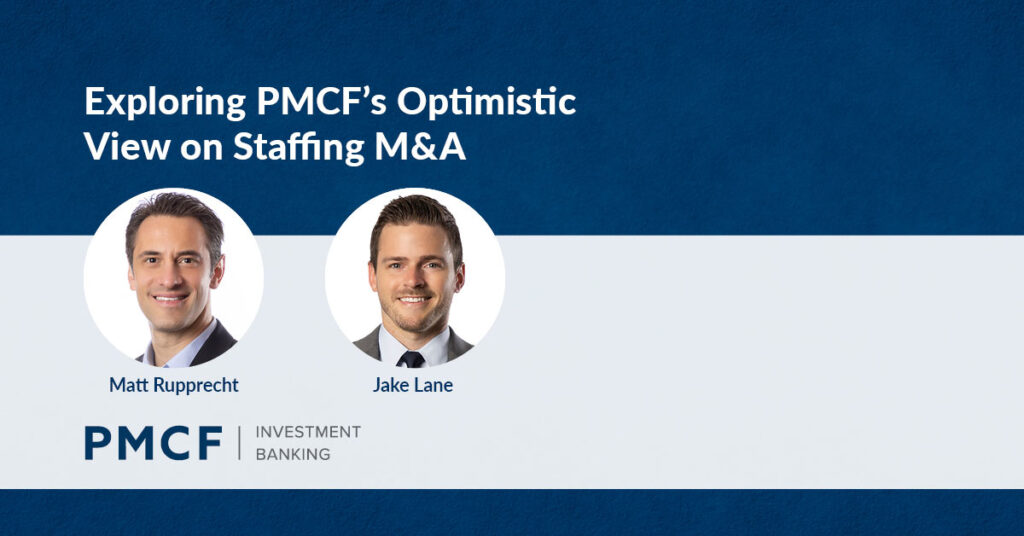Following unprecedented post-pandemic performance in 2022, the Human Capital Management industry has undergone a lengthy period of unpredictability due to market “right sizing” and dynamic challenges for key client industries, such as manufacturing and warehousing.
Despite successive years of U.S. GDP growth and the advent of innovative staffing platform technologies, the industry has observed declining demand and narrowing margins. Given the circumstances, M&A activity across staffing and outsourcing services has remained resilient, with creativity in deal structures and lending solutions emerging as a means of transacting on premium assets in a volatile market.
As we shift our focus to 2025, M&A activity is poised for a significant rebound due to indications of a recovering labor market and increasing buyer appetite. PMCF has identified five key reasons for optimism in Staffing M&A as we look ahead to the next 12 months:
1) Key Indicators of a Healthy Labor Market are Returning to Pre-Pandemic Levels
The labor market faced significant challenges in the wake of COVID-19 and continued to struggle in the following years. Widespread layoffs, business closures, and overall macroeconomic uncertainty burdened employment across various industries. As the world separates from the pandemic era, key indicators in the labor market have stabilized, indicating upward trends in the staffing industry.
Since plateauing during the pandemic, unemployment has decreased to around 4.2%, which is on par with healthy pre-pandemic levels. Personal income and consumer spending continue to rise heading into 2025, along with real GDP, which is estimated to see an annualized increase of ~3% in 2024. Employment has rebounded in key staffing sectors, on par with pre-COVID levels. Industries like manufacturing and healthcare have experienced a notable increase in job creation in the second half of 2024, positioning them for continued expansion heading into 2025.
2) Private Equity Dry Powder Remains at Record Highs
Consistent with the 2024 M&A environment, private equity (PE) funds are anticipated to enter 2025 with record levels of available capital, or ‘dry powder’, following several years of transaction stagnation. Many PE funds have extended their holding periods in recent years due to a less than ideal market. With investors’ increasing pressure to monetize a portfolio of mature assets, PE exits are anticipated to ramp up in 2025 which, in turn, will drive the need for new acquisitions across popular industry sectors in the middle market.
Human Capital Management remains largely unsaturated by private equity, representing significant opportunity as funds begin searching for quality assets in promising sectors. Optimism around staffing and outsourcing services is anticipated to increase private equity activity in the space as the prospect of a strong ROI becomes more apparent. Increased dealmaking, paired with falling interest rates and easing inflation, is setting the stage for growth in valuation multiples. Staffing agencies that have been contemplating a transaction in recent years may be enticed to enter the market sooner rather than later.
3) Anticipated Surge in Demand for Outsourcing Services
Shifting workforce cultures in recent years have changed the landscape of the staffing industry. The advent of remote work environments, coupled with a rise in contingent workforce programs, has fueled demand for staffing and outsourcing services businesses. As companies embrace flexible work models, they become increasingly reliant on third-party providers to manage tasks including IT support, customer service, human resources, payroll, and more.
This increased demand for outsourcing services is matched by a growing contingent workforce, which includes freelancers and temporary staff. Companies continue to benefit from the scalability and cost-efficiency that is offered by outsourcing certain workstreams, leading to a rise in demand for these managed services, a trend that is only expected to amplify in 2025.
4) Creativity in Deal Structure Lends Itself to Higher Close Rates
Over 2 years of suppressed M&A activity due to the gap in buyer and seller valuation expectations has led to increased creativity in deal terms to help satisfy both parties and drive transactions across the finish line. This includes alternative structures such as partnerships, alliances, seller equity rollover, earnouts, and other forms of capital structuring. Lengthier due diligence processes, sell-side quality of earnings (QoE) analyses, and the inclusion of representations & warranties (R&W) insurance also help address acquiror caution in an evolving M&A landscape.
This is particularly important across the Human Capital Management industry, which has dealt with suboptimal performance on a macro level for the past 18-24 months. Alternative deal structures help bolster dealmaking activity, generating buyer confidence in future returns even as companies work to recover from a less than ideal trailing twelve-month (TTM) period in terms of financial performance. While the gap in valuation expectations begins to narrow, the tailoring of deal terms around a specific transaction’s concerns and uncertainties has become commonplace and should aid in boosting close rates as staffing M&A activity increases.
5) Favorable Regulatory Changes Following the 2024 U.S. Presidential Election
Leading up to the 2024 U.S. presidential election, there was apprehension regarding dealmaking due to uncertainty around changes in policies impacting Human Capital Management. With the Trump Administration reintroducing policies focused on economic growth, deregulation, and domestic hiring, the staffing industry is anticipated to observe both new opportunities and challenges in 2025.
First, the Trump Administration’s focus on reduced regulatory oversight is aimed to simplify compliance practices and reduce restrictions on businesses, making it easier for companies to grow and expand their workforce. Ideally, this will accelerate hiring rates and drive demand for flexible staffing solutions as businesses aim to quickly respond to favorable regulatory conditions. The rapid changes in workforce needs may have a significant impact on demand for temporary staffing solutions in particular.
Second, the United States’ shifting economic agenda focused on reducing foreign dependency puts the spotlight on the manufacturing and energy sectors, which are likely to observe a spike in demand for skilled workers as domestic production becomes a higher priority. Staffing firms specializing in manufacturing, oil & gas, and alternative energy may anticipate an uptick in demand as the Trump Administration incentivizes companies to focus on domestic operations. Similarly, the emphasis on America’s healthcare system in terms of reducing costs and improving accessibility may drive demand for both clinical and non-clinical healthcare workers in response to favorable policy adjustments.
Lastly, the incoming administration’s focus on employing U.S. citizens represents a double-edged sword for staffing agencies. Hiring practices for agencies with an international talent pool will be required to shift in order to reduce dependence on immigrant workers. Adjusting recruiting strategies and introducing new training practices to re-skill domestic workers may lead to higher up-front costs. However, demand from traditionally immigrant-reliant industries such as agriculture, business services, and construction may increase with regulation favoring the hiring of U.S.-based workers.
Final Thoughts
It has been a challenging few years in staffing and outsourcing services while the industry normalizes following record post-pandemic performance in 2021 & 2022. M&A activity dropped significantly as the market prepared for an impending recession amidst record inflation and geopolitical tensions. Now, with interest rate cuts and modest GDP growth observed in 2024, the macroeconomic environment appears to be shifting in favor of a long-awaited upswing.
Tailwinds in the Human Capital Management industry such as a growing contingent workforce, advancements in staffing platform technologies, and increased temporary labor demand in key sectors like manufacturing and warehousing set the stage for an exciting dealmaking environment in 2025. The PMCF team remains committed to serving its staffing and outsourcing services clientele, helping prospective buyers and sellers navigate the new complexities of a dynamic and reenergized Human Capital Management M&A market.





